Film fights back
by John Henshall
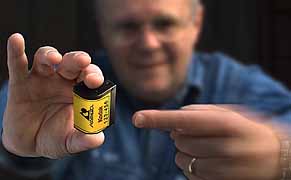
The APS cassette.

Thirty years ago, products such as calculators,
faxes, personal computers, VCRs and cellular telephones did not exist. Today
they have become 'how did we ever do without them' products.
Thirty years ago, photography was a mature industry and the advances made
since then have been comparatively modest. Features such as autofocus and
built-in exposure control have become the norm, it's true, but to many consumers
- who simply want to record their family memories without any fuss - cameras
remain a user un-friendly mystery. To them, luck seems to play a significant
part in the uncertainty of picture making.
Recorded sound, another mature industry, has been with us for over a hundred
years. In the late 'fifties, 'unbreakable' microgroove LPs displaced fragile
shellac 78s and brought with them major improvements in sound quality and
playing time. LPs lasted until records changed from being boring big and
black to sophisticated small and silver. At first the changeover was slow
but it is now virtually complete, with almost total acceptance of the Compact
Disc format, even to the extent of duplicating established vinyl record
collections with the same titles on CD. They give us major feature and quality
improvements, coupled with greater convenience. Audio CDs are digital, though
the user need never be aware of their digital form. Most importantly, the
record manufacturers have been able to persuade us all to pay premium prices
for this new technology.
What a boost something like that would give to the ailing photographic industry,
ever complaining about the depressed state of the market. In fact, more
pictures are being taken today than ever before, though almost one roll
in twenty still turns joy to disappointment. With a worldwide sale of about
two billion rolls of film a year, almost one roll in twenty - about a hundred
million rolls a year - have double exposed, blank or fogged frames.
It's not good for photography when fond memories are replaced by the sadness
and frustration of failure to record it on film. It's still too easy for
the leader not to attach itself correctly inside the camera, resulting in
a blank film. No wonder so many consumers continue to balk at the thought
of loading a film into their camera. Using a camera is inextricably linked
with ineptitude for many would-be users, who do not think of photography
as an enjoyable pastime. It's time to use late twentieth century technology
to turn picture making into the delight it should be. Anything which enhances
consumer delight must be good for the photographic industry.
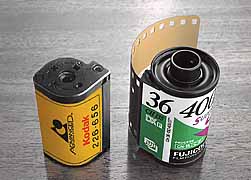
Unfortunately, when it comes to introducing new
formats the photographic industry has a bad record. Remember 126, 110 and
Disc? Meanwhile, most consumer cameras continue to use 35mm. The failures
of 35mm's erstwhile contenders have been acute embarrassments to their proponents.
Hopefully the manufacturers who introduced them have learned by their mistakes.
Canon, Fuji, Kodak, Minolta and Nikon have now come together in an alliance
to give photography a shot in the arm with a new format being planned like
a military operation. This in itself is incredible - five major manufacturers
agreeing on the way forward. In how many other industries could that happen?
The new system is called the Advanced Photo System.
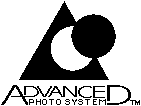
The stakes are high. If they get this one wrong, it could turn out to
be the last major development in consumer film and camera technology before
digital takes over. But there's plenty of life left in silver halide, a
superb image recording system with a century and a half of evolution. Got
right, it could hold digital at bay for quite a few years more. And though
we look to a digital future, it's sobering to remind ourselves that much
of the population of the third world has yet to take its first photograph.
The APS system is due to be launched in Spring 1996 but, to ensure that
processing laboratories are ready from the outset, the photofinishing equipment
is being launched now, in the hope that everything will be in place for
the roll out of the entire system. Now is the time of those of you who are
laboratory owners and believe in the future of silver halide to get out
your cheque books and invest - if that is the correct word - in APS. You
are being asked to do this on a series of promises now being backed up with
demonstrations of laboratory equipment seen in action.
Eastman Kodak held simultaneous presentations in Dallas, Paris and Tokyo
on 19 October 1995 - the first demonstrations of APS to the trade press.
Chip Shop attended the Paris event where a bullish Kodak team, partnered
by Gretag, Noritsu and Systel, demonstrated their new lab equipment. Kodak
seemed a little frustrated that the agreement between the APS System Developing
Companies (SDCs) only enabled them to show us the photofinishing equipment
at this stage.
The Agfa event, in Leverkusen, Germany on 20 October, was somewhat less
action packed. Four of the five SDCs are Japanese, one American. There are
no Europeans. Agfa - along with forty-odd others - are licensees of the
system. Agfa's Friedrich Hujer felt that the SDC may now be feeling that
it was a mistake not to have Agfa on board from the beginning but made light
of the situation, saying, "Even adopted children can thrive."
Agfa emphasised that existing 35mm photofinishing products can be adapted,
unlike processing equipment for the Disc system which required a completely
new processing line.
Fuji waited until PMA/PIE to unveil its plans but is rumoured to have a
stunning APS emulsion in the wings. Those who have seen early examples of
Fuji's big enlargements have been astounded by the quality.
APS is a hybrid system which owes a lot to electronic
technology which is being used to bring innovation, without hassle, to film-based
photography. Like 35mm, APS uses a film cartridge - Kodak prefer to call
it a cassette - though it is slightly smaller than 135 size. This holds
a roll of strong but thin polyethylene naptholate (PEN) based film, instead
of the cellulose triacetate film used for 35mm. The film is 24mm wide and
will be available in 15, 25 or 40 exposure lengths. A very thin transparent
magnetic coating on its back enables the magnetic recording of exposure-specific
information by the camera. Each cassette has an identification number which
cross-references from the number on an index print similar to those with
Photo-CD. Each individual frame of the film is scanned and digitised to
reproduce the index prints, which will also become available with standard
35mm film processing, making re-orders much easier.

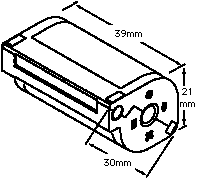
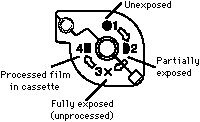
Film status indicators on the cassette indicate
whether the film inside it is unexposed, partly exposed, fully exposed but
unprocessed, or processed film (negatives) - cassettes being re-used for
the storage of processed negatives. Gone is the handling of negatives. Users
will never see the film - just as they never see the videotape in video
cassettes. Simple drop-in film loading uses no leader extending from the
cassette and prevents double exposed, fogged and blank rolls. All these
facilities are designed to increase user satisfaction and confidence. For
the first time, it will be easy to change a film in the middle of a roll
- for example to a faster emulsion - though the use of this facility is
somewhat limited by the probable unavailability of black and white and colour
reversal stocks.

The smaller film size will expose a frame of similar aspect ratio to
16:9 high definition and other widescreen television. The 16.7x30.2 frame
is 1.8 to 1 ratio - wider than the existing 35mm format of 1.5 to 1. Three
choices of print formats will be available: H(DTV) 1.8 to 1 giving 3.5x6
or 4x7 inch prints and using the full frame, C(lassic) 1.5 to 1 giving 3.5x5
or 4x6 inch prints and P(anoramic) 2.9 to 1 giving 3.5x10 or 4x11.5 inch
prints. All expose the full frame area, recording the cropping data magnetically
on the film to be used at the time of printing. You can change your mind
for later re-orders. In the more distant future, a 'zoom' lens effect without
moving lens elements will be achieved by recording variable cropping data
to control selective enlargement during printing. All the prints have provision
to carry two lines of forty characters printed on the back, carrying exposure
information such as date, time and location. More advanced cameras will
enable customised back-printing.

At present only 2% of negatives are reprinted or
enlarged but even this modest percentage accounts for $7 billion of business
each year. APS will make reprint orders much easier, with no more squinting
at negatives, no more greasy fingerprints. If APS persuades more consumers
to go for reprints, a one percent increase in this business would be worth
$3.5 billion. Worth having?
You might ask why all this technology is not being applied to the existing
35mm format. To quote Agfa's Friedrich Hujer, that is "a good - but
academic - question." The smaller frame size is bound to arouse anxiety
for professional and advanced amateur users who remember the poor quality
of some of the earlier 'wonder' formats. The APS frame area is 504 sq mm
- just under two thirds of the area of a frame of 35mm - though it must
be remembered that today's advanced 35mm emulsions have plenty of redundant
information for the degree of enlargement they normally receive. Better
news is that APS is over twice the area of 110 and over six times the area
of the Disc format.
The smaller format means that a 'standard lens' - roughly equivalent to
the diagonal of the format - will be 35mm. Many full-frame 35mm compact
cameras sport 35mm wideangle lenses, the APS equivalent of these being 24mm.
APS cameras will therefore be up to 25% smaller than their 35mm counterparts.
A camera which fits into a shirt pocket without tugging at the stitching
might just be the kind of sexy image recording device which people will
always carry with them. When Boots in Wantage can do the processing in an
hour, I'll buy one to carry with me around trade shows. Quality would be
more than adequate for editorial pictures.
If APS takes off we will soon see other domestic products which link it
to digital imaging, such as analogue scanners to 'project' negatives onto
a tv set and digital scanners to enable images to be brought into home computers.
Locked inside its APS cassette, film will become invisible - almost irrelevant
- to the user. It is reduced to a data storage medium - a great one at that.
But when the tactile experience has gone the recording medium becomes irrelevant.
One day someone will introduce an inexpensive consumer digital imaging system
which does not need processing, can be viewed on a tv set and automates
the production of full colour A4 prints on plain paper. Until that day,
APS may be precisely the move from cost to value marketing which photography
has been looking for. It brings film closer to the digital age and could
give photography a higher priority on family budgets.
The big question now is will the commitment of the System Developing Companies
and licensees be matched by the laboratories, photo dealers and public?
For photography's sake, let's hope so.